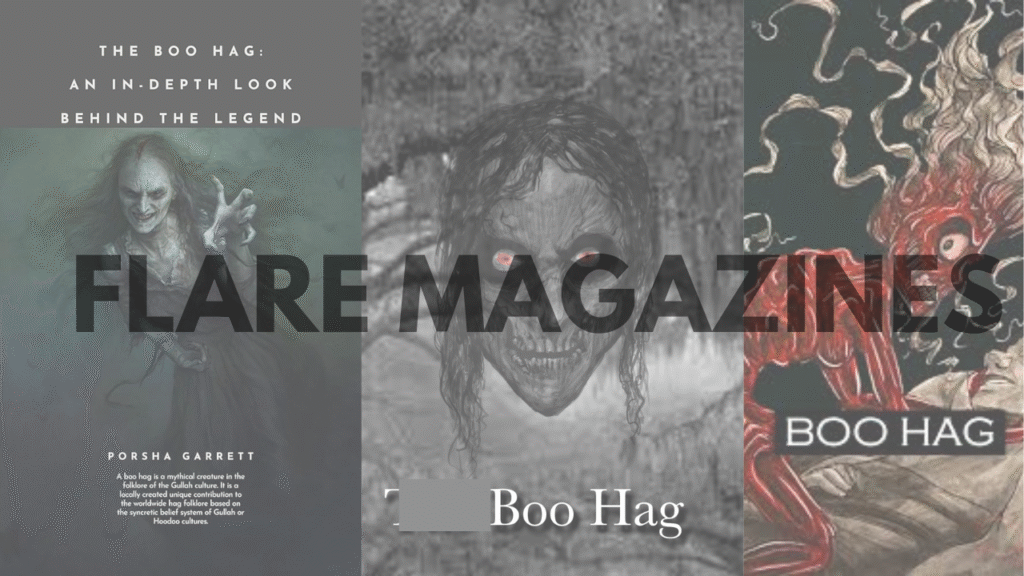Boo Hag Legend
Folklore has always been a way for communities to explain the unexplainable, warn of dangers, and pass traditions from generation to generation. Among the eerie legends of the American South, Boo Hag stands out as one of the most haunting. Rooted in Gullah culture, boo hag is a mythical creature said to steal the breath and energy of its victims while they sleep. Unlike vampires who drink blood, Boo Hags thrive on life force, leaving their victims weak and exhausted.
But what exactly is a Boo Hag? Where did the legend come from, and why does it still capture imaginations today? This article takes a deep dive into the history, myths, and cultural significance of boo hag, while also exploring ways people claimed to protect themselves from these sinister beings.
What is a Boo Hag?
A Boo Hag is a supernatural creature from Gullah folklore (the Gullah people are descendants of enslaved Africans in the coastal regions of South Carolina and Georgia). The legend describes boo hag as:
- A skinless creature, red and raw in appearance.
- Able to shed its skin and wear it like clothing to appear human.
- A parasite of energy, feeding on human breath and life force instead of blood.
- A nocturnal being that attacks when people are asleep, sitting on their chest and “riding” them until dawn.
This terrifying folklore has similarities to sleep paralysis experiences, where individuals wake up unable to move and feel pressure on their chest.
Origins of boo hag in Gullah Folklore
The Gullah people developed rich storytelling traditions blending West African spiritual beliefs with European and Native American influences. boo hag legend likely originated as a cautionary tale to:
- Explain nighttime terrors like sleep paralysis and bad dreams.
- Teach moral lessons, especially warning children against disobedience.
- Represent the dangers of hidden evil disguised in plain sight.
In Gullah oral tradition, boo hag is closely connected to witchcraft and the belief that not all evil is visible. According to lore, “If you’re not careful, boo hag will steal your skin and your soul.”
Read more about Gullah culture.
Boo Hag vs. Vampire: Key Differences
Although boo hag shares some similarities with vampire legends, the two are distinct.
| Feature | Boo Hag | Vampire |
|---|---|---|
| Origin | Gullah folklore (U.S.) | European folklore |
| Appearance | Skinless, red, raw; can wear stolen skin | Pale, often elegant, fanged |
| Food source | Breath and life force | Blood |
| Attack method | Sits on chest, causes sleep paralysis | Bites neck, drinks blood |
| Weaknesses | Sunlight, being discovered, ash/salt | Sunlight, garlic, holy water |
This table highlights how Boo Hags are unique to Southern folklore, rooted in cultural traditions rather than European horror.
How Boo Hag Attacks
boo hag’s attack is one of the most chilling parts of the legend. Here’s how it is described in folklore:
- Skin Shedding – At night, boo hag sheds its skin and hides it.
- Infiltration – It slips into a victim’s home, often through cracks or keyholes.
- Riding – The hag sits on the victim’s chest and “rides” them, sucking out their breath and energy.
- Aftermath – Victims wake up weak, sweaty, and exhausted. If ridden too often, they may die.
- Return – Before dawn, boo hag must return to its hidden skin. If the skin is destroyed or salted, it cannot wear it again.
This “riding” is likely an explanation for nightmares and sleep paralysis—a phenomenon where people feel suffocated in their sleep.
Signs You’ve Been Visited by a Boo Hag
According to Gullah lore, victims of a Boo Hag often experience:
- Waking up tired despite sleeping all night.
- Shortness of breath or chest heaviness.
- Night sweats and trembling.
- A sense of being watched in the dark.
- Sudden unexplained fatigue during the day.
In extreme cases, repeated visits from a Boo Hag could result in death from exhaustion.
How to Protect Yourself from a Boo Hag
The Gullah people developed various ways to protect themselves from Boo Hags. These methods blend spiritual beliefs with practical superstition:
- Salt and Pepper – Sprinkling salt or pepper around the bed or house confuses boo hag.
- Brooms or Sieves – Placing a broom or colander near the door forces the hag to count each bristle or hole, delaying it until sunrise.
- Ash at the Doorstep – A hag stepping in ash would leave footprints, exposing its presence.
- Destroying the Skin – If you find boo hag shed skin, salting or burning it prevents the creature from returning to human disguise.
These traditions highlight the creativity and symbolism in Gullah folklore, where everyday objects became powerful tools against evil.
Boo Hag in Modern Pop Culture
While not as mainstream as vampires or werewolves, boo hag has appeared in books, shows, and cultural discussions:
- Books: The legend appears in children’s folklore collections and ghost story anthologies.
- TV & Film: boo hag has been referenced in paranormal documentaries and Southern Gothic horror works.
- Cultural Tourism: Some Charleston, SC ghost tours include Boo Hag tales as part of their storytelling.
Psychological and Cultural Interpretations
boo hag legend may have been an early way to explain sleep paralysis, a condition where a person wakes up unable to move, often with sensations of being suffocated.
From a cultural perspective, boo hag represents:
- Hidden dangers – Evil disguised in human skin.
- Energy drain – Symbolic of toxic relationships or exploitation.
- Moral warnings – A reminder to live righteously, as immoral people could fall victim more easily.
By connecting folklore to real human experiences, boo hag becomes more than just a monster—it becomes a reflection of human fears.
Explore More Articles
Leslie Knipfing: Complete Biography, Career, Family, and Everything to Know
Tyson Fight Time: Everything You Need to Know
Craigslist Wichita KS: The Ultimate Local Guide to Jobs, Housing, Cars & More (Updated: 2025)
Tory Lanez Height – What Official Records Actually Say
Solica Casuto: The Untold Story of Andy Griffith’s Mysterious Second Wife
Straw Ber Rita Guide: Flavor, Alcohol %, Price & Best Uses
FAQs About boo hag
1. What is a Boo Hag?
A Boo Hag is a creature from Gullah folklore that feeds on human breath and energy by sitting on victims’ chests at night.
2. Is boo hag real?
While there’s no scientific evidence of its existence, the legend is deeply rooted in Gullah storytelling and may be linked to sleep paralysis experiences.
3. How do you stop a Boo Hag?
Traditionally, placing salt, brooms, or sieves near your bed was believed to deter them. Destroying their shed skin also made them powerless.
4. Are Boo Hags the same as vampires?
No. Vampires drink blood, while Boo Hags feed on breath and energy. Boo Hags also come from African-American Gullah folklore, not European traditions.
5. Can Boo Hags kill you?
According to folklore, yes. If a Boo Hag rides a person too many times, the victim could die from exhaustion.
Conclusion: Why boo hag Still Haunts Us
boo hag legend is more than just a ghost story—it’s a cultural treasure of the Gullah people, blending folklore, spirituality, and human psychology. Whether seen as a supernatural monster or a metaphor for real-life struggles, boo hag continues to fascinate storytellers, folklorists, and paranormal enthusiasts alike.
In today’s world, the tale reminds us of the power of oral traditions and the way stories shape our understanding of fear. So next time you feel a weight on your chest at night, you might wonder—was it just sleep paralysis, or did a Boo Hag come riding?







